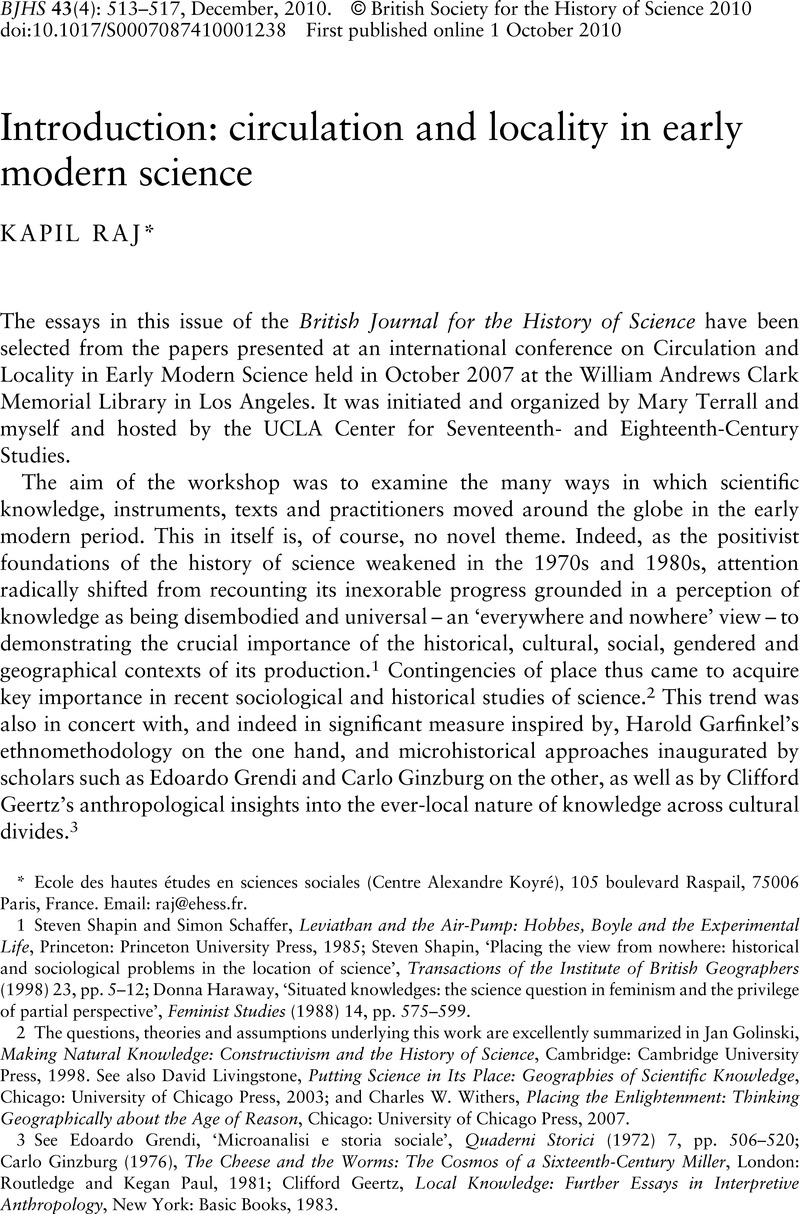Article contents
Introduction: circulation and locality in early modern science
Published online by Cambridge University Press: 01 October 2010
Abstract

- Type
- Research Article
- Information
- The British Journal for the History of Science , Volume 43 , Issue 4: Circulation and Locality in Early Modern Science , December 2010 , pp. 513 - 517
- Copyright
- Copyright © British Society for the History of Science 2010
References
1 Shapin, Steven and Schaffer, Simon, Leviathan and the Air-Pump: Hobbes, Boyle and the Experimental Life, Princeton: Princeton University Press, 1985Google Scholar; Shapin, Steven, ‘Placing the view from nowhere: historical and sociological problems in the location of science’, Transactions of the Institute of British Geographers (1998) 23, pp. 5–12CrossRefGoogle Scholar; Haraway, Donna, ‘Situated knowledges: the science question in feminism and the privilege of partial perspective’, Feminist Studies (1988) 14, pp. 575–599CrossRefGoogle Scholar.
2 The questions, theories and assumptions underlying this work are excellently summarized in Golinski, Jan, Making Natural Knowledge: Constructivism and the History of Science, Cambridge: Cambridge University Press, 1998Google Scholar. See also Livingstone, David, Putting Science in Its Place: Geographies of Scientific Knowledge, Chicago: University of Chicago Press, 2003CrossRefGoogle Scholar; and Withers, Charles W., Placing the Enlightenment: Thinking Geographically about the Age of Reason, Chicago: University of Chicago Press, 2007CrossRefGoogle Scholar.
3 See Grendi, Edoardo, ‘Microanalisi e storia sociale’, Quaderni Storici (1972) 7, pp. 506–520Google Scholar; Ginzburg, Carlo (1976), The Cheese and the Worms: The Cosmos of a Sixteenth-Century Miller, London: Routledge and Kegan Paul, 1981Google Scholar; Geertz, Clifford, Local Knowledge: Further Essays in Interpretive Anthropology, New York: Basic Books, 1983Google Scholar.
4 See, for instance, Collins, Harry M., Changing Order: Replication and Induction in Scientific Practice, London: Sage, 1985Google Scholar; Latour, Bruno, Science in Action: How to Follow Engineers through Society, Milton Keynes: Open University Press, 1987Google Scholar, Chapter 6; Star, Susan Leigh and Griesemer, James R., ‘Institutional ecology, “translations” and boundary objects: amateurs and professionals in Berkeley's Museum of Vertebrate Zoology, 1907–39’, Social Studies of Science (1989) 19, pp. 387–420CrossRefGoogle Scholar; Galison, Peter L., Image and Logic: A Material Culture of Microphysics, Chicago, 1997, pp. 803–844Google Scholar.
5 For one of the first of the ‘postpositivist’ generation of scholars to dwell on the question of the manner in which knowledge and skills are communicated see Dolby, R.G.A., ‘The transmission of science’, History of Science (1977) 15, pp. 1–43CrossRefGoogle Scholar. See also Bourguet, Marie-Noëlle, Licoppe, Christian and Otto Sibum, H. (eds.), Instruments, Travels and Science: Itineraries of Precision from the Seventeenth to the Twentieth Century, London: Routledge, 2002CrossRefGoogle Scholar; Secord, James A., ‘Knowledge in transit’, Isis (2004) 95, pp. 654–672CrossRefGoogle ScholarPubMed.
6 See, for instance, Brockway, Lucile H., Science and Colonial Expansion: The Role of the British Royal Botanic Gardens, New York: Academic Press, 1979Google Scholar; MacLeod, Roy M., ‘On visiting the “moving metropolis”: reflections on the architecture of imperial science’, Historical Records of Australian Science (1982) 5, pp. 1–16CrossRefGoogle Scholar; Kumar, Deepak (ed.), Science and Empire: Essays in Indian Context, Delhi: Anamika Publications, 1991Google Scholar; Petitjean, Patrick, Jami, Catherine and Moulin, Anne-Marie (eds.), Science and Empires, Dordrecht: Kluwer, 1992CrossRefGoogle Scholar; MacLeod, Roy M. (ed.), Nature and Empire, Osiris (2000) 15Google Scholar; idem, ‘Focus: colonial science’, Isis (2005) 96, pp. 52–87.
7 For the classic, and clearest, statement of the diffusionist view, see Basalla, George, ‘The spread of western science’, Science (1967) 156, pp. 611–622CrossRefGoogle ScholarPubMed.
8 See Edward Shils, ‘Centre and periphery’, in The Logic of Personal Knowledge: Essays Presented to Michael Polanyi on His Seventieth Birthday, 11th March 1961, London: Routledge and Kegan Paul, 1961, pp. 117–130; Prebisch, Raúl, The Economic Development of Latin America and Its Principal Problems, New York: Economic Commission for Latin America, 1950Google Scholar.
9 For the fluidity of an object as a characteristic of its mobility, see de Laet, Marianne and Mol, Annemarie, ‘The Zimbabwe bush pump: mechanics of a fluid technology’, Social Studies of Science (2000) 30, pp. 225–263CrossRefGoogle Scholar; For plasticity and robustness, see Star and Griesemer, op. cit. (4).
10 Claude Markovits, Jacques Pouchepadass and Sanjay Subrahmanyam, ‘Introduction: circulation and society under colonial rule’, in idem (eds.), Society and Circulation: Mobile People and Itinerant Cultures in South Asia 1750–1950, Delhi: Permanent Black, 2003, pp. 1–22, 2–3.
11 See, for example, Hostetler, Laura, Qing Colonial Enterprise: Ethnography and Cartography in Early Modern China, Chicago: University of Chicago Press, 2001Google Scholar; Cook, Harold J., Matters of Exchange: Commerce, Medicine, and Science in the Dutch Golden Age, New Haven: Yale University Press, 2007CrossRefGoogle Scholar; Simon Schaffer, ‘The information order of Newton's Principia Mathematica’, Hans Rausing Lecture, Uppsala, 2008; for knowledge circulating across geographically proximate but distinct groups of specialist practitioners, see Otto Sibum, H., ‘Les Gestes de la mesure. Joule, les pratiques de la brasserie et la science’, Annales HSS (1998) 53, pp. 745–774CrossRefGoogle Scholar.
12 Based on a doctoral seminar I ran with my colleague Yves Cohen between 2002 and 2006 at the Ecole des hautes études en sciences sociales, we are in the process of completing a substantive methodological essay on circulation as a fruitful approach to transnational historiography, ‘Localités et circulations: Pour des Etudes transnationales et mondiales ancrées’, in which many of the themes mentioned here will be further developed.
13 Ophir, Adi and Shapin, Steven, ‘The place of knowledge: a methodological survey’, Science in Context (1991) 4, pp. 3–21CrossRefGoogle Scholar, 16.
- 40
- Cited by




